International Marketing Case Study: Podpac's India Market Strategy
VerifiedAdded on 2023/01/16
|16
|1460
|48
Presentation
AI Summary
This presentation analyzes Podpac, an Australian SME, and its international marketing strategy for entering the Indian market. The presentation begins with an introduction to international marketing and Podpac's background, highlighting its innovative approach to Nespresso pods. It then explores the attractiveness of the Indian food and beverage market, providing market analysis data and trends. A PESTLE analysis is conducted to assess the political, economic, social, technological, legal, and environmental factors in India. The presentation also examines the geographic, demographic, psychographic, and behavioral characteristics of the Indian market, followed by marketing strategies and competitive analysis. The document concludes with a summary of key findings and recommendations for Podpac's successful market entry, including a list of references.
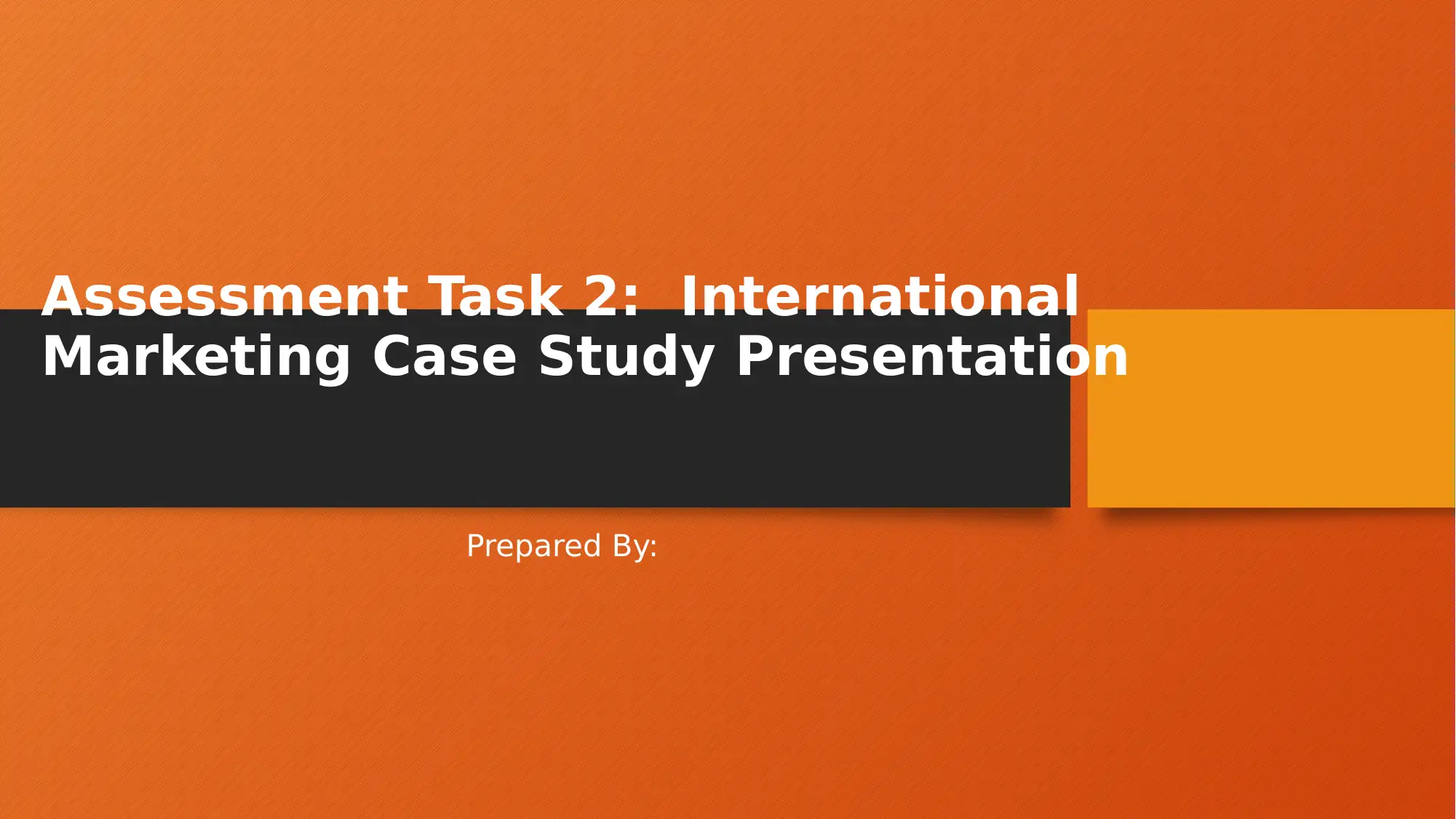
Assessment Task 2: International
Marketing Case Study Presentation
Prepared By:
Marketing Case Study Presentation
Prepared By:
Paraphrase This Document
Need a fresh take? Get an instant paraphrase of this document with our AI Paraphraser
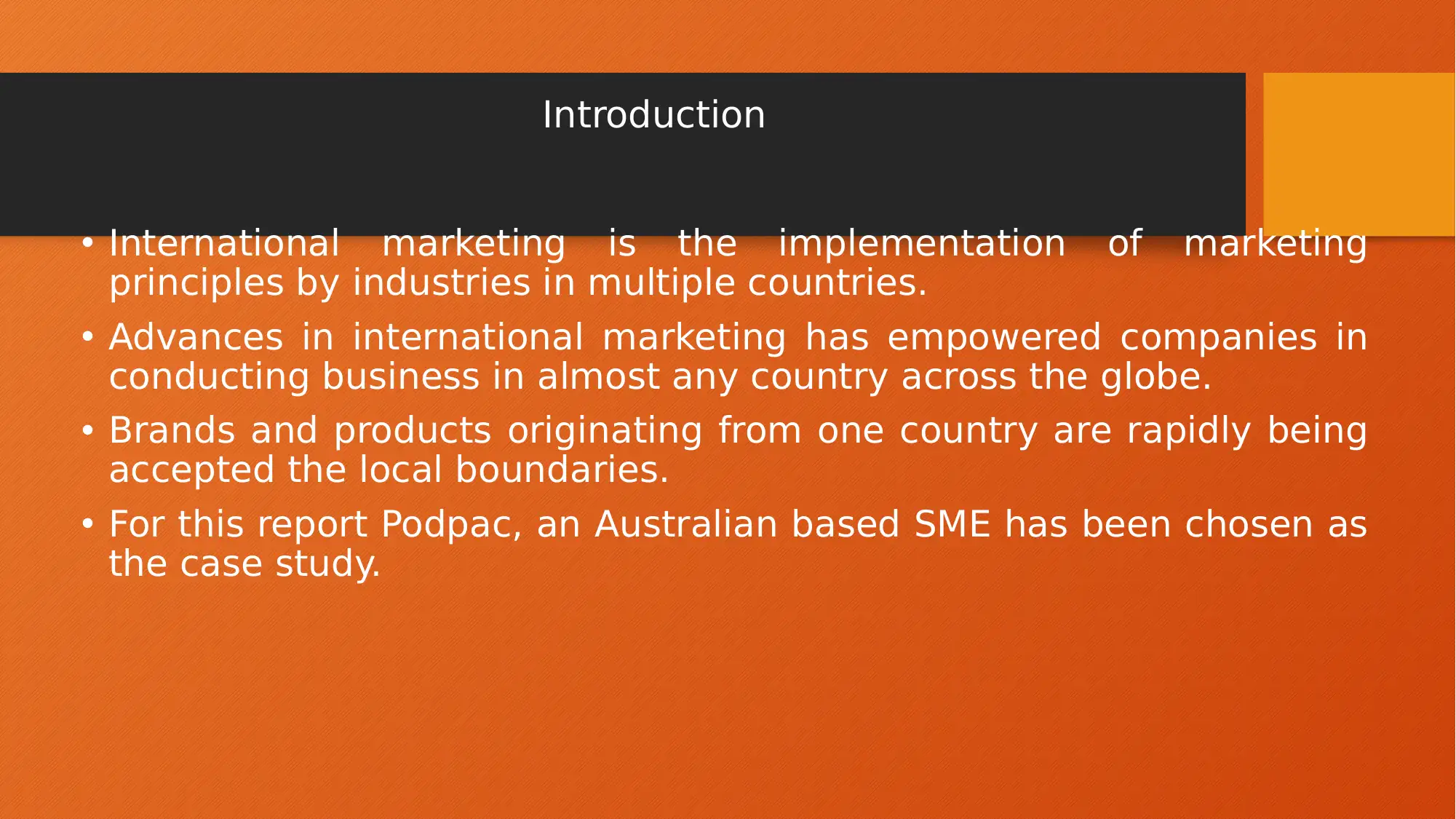
Introduction
• International marketing is the implementation of marketing
principles by industries in multiple countries.
• Advances in international marketing has empowered companies in
conducting business in almost any country across the globe.
• Brands and products originating from one country are rapidly being
accepted the local boundaries.
• For this report Podpac, an Australian based SME has been chosen as
the case study.
• International marketing is the implementation of marketing
principles by industries in multiple countries.
• Advances in international marketing has empowered companies in
conducting business in almost any country across the globe.
• Brands and products originating from one country are rapidly being
accepted the local boundaries.
• For this report Podpac, an Australian based SME has been chosen as
the case study.
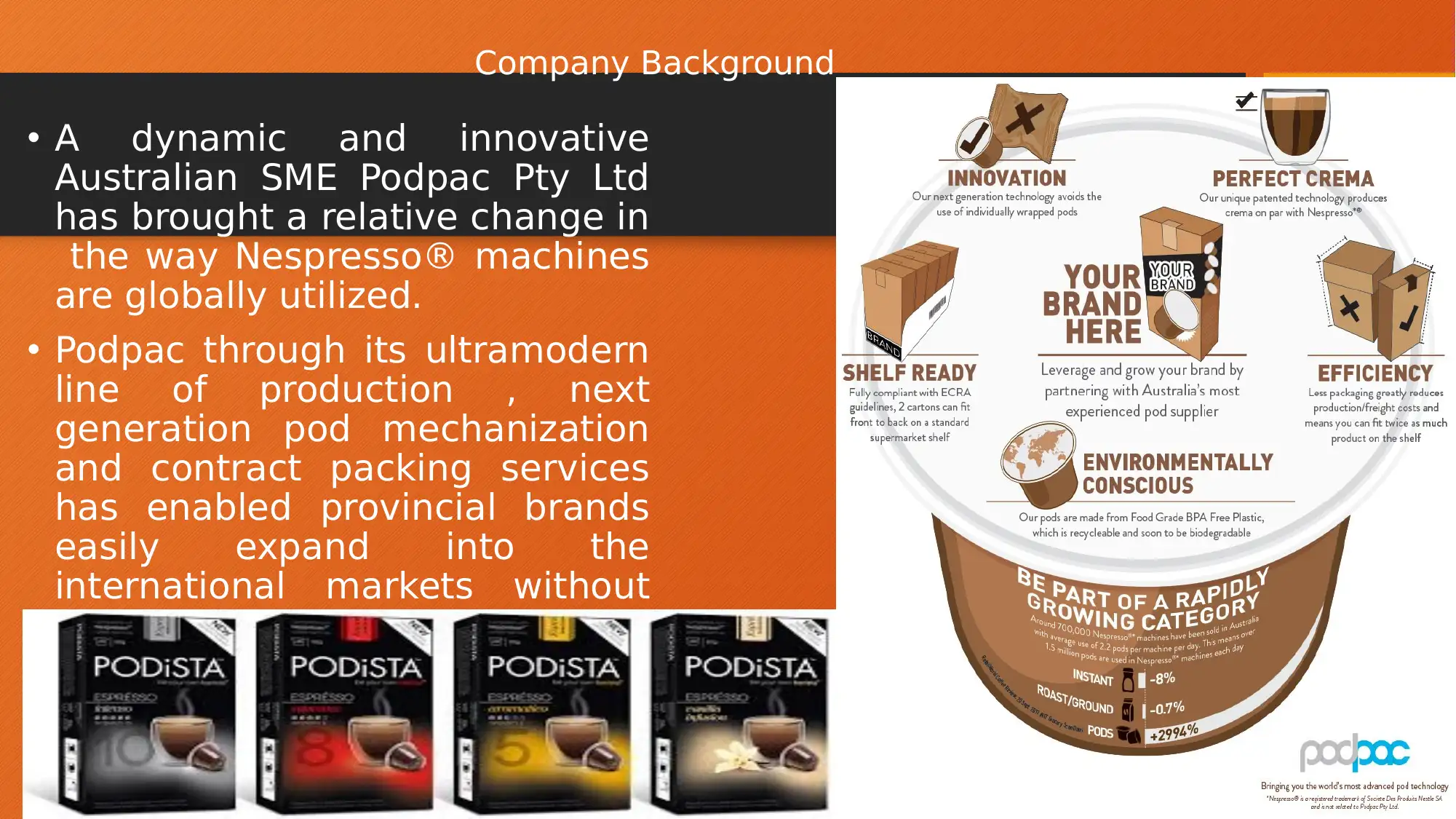
Company Background
• A dynamic and innovative
Australian SME Podpac Pty Ltd
has brought a relative change in
the way Nespresso® machines
are globally utilized.
• Podpac through its ultramodern
line of production , next
generation pod mechanization
and contract packing services
has enabled provincial brands
easily expand into the
international markets without
disrupting their current
operation.
• A dynamic and innovative
Australian SME Podpac Pty Ltd
has brought a relative change in
the way Nespresso® machines
are globally utilized.
• Podpac through its ultramodern
line of production , next
generation pod mechanization
and contract packing services
has enabled provincial brands
easily expand into the
international markets without
disrupting their current
operation.
⊘ This is a preview!⊘
Do you want full access?
Subscribe today to unlock all pages.

Trusted by 1+ million students worldwide
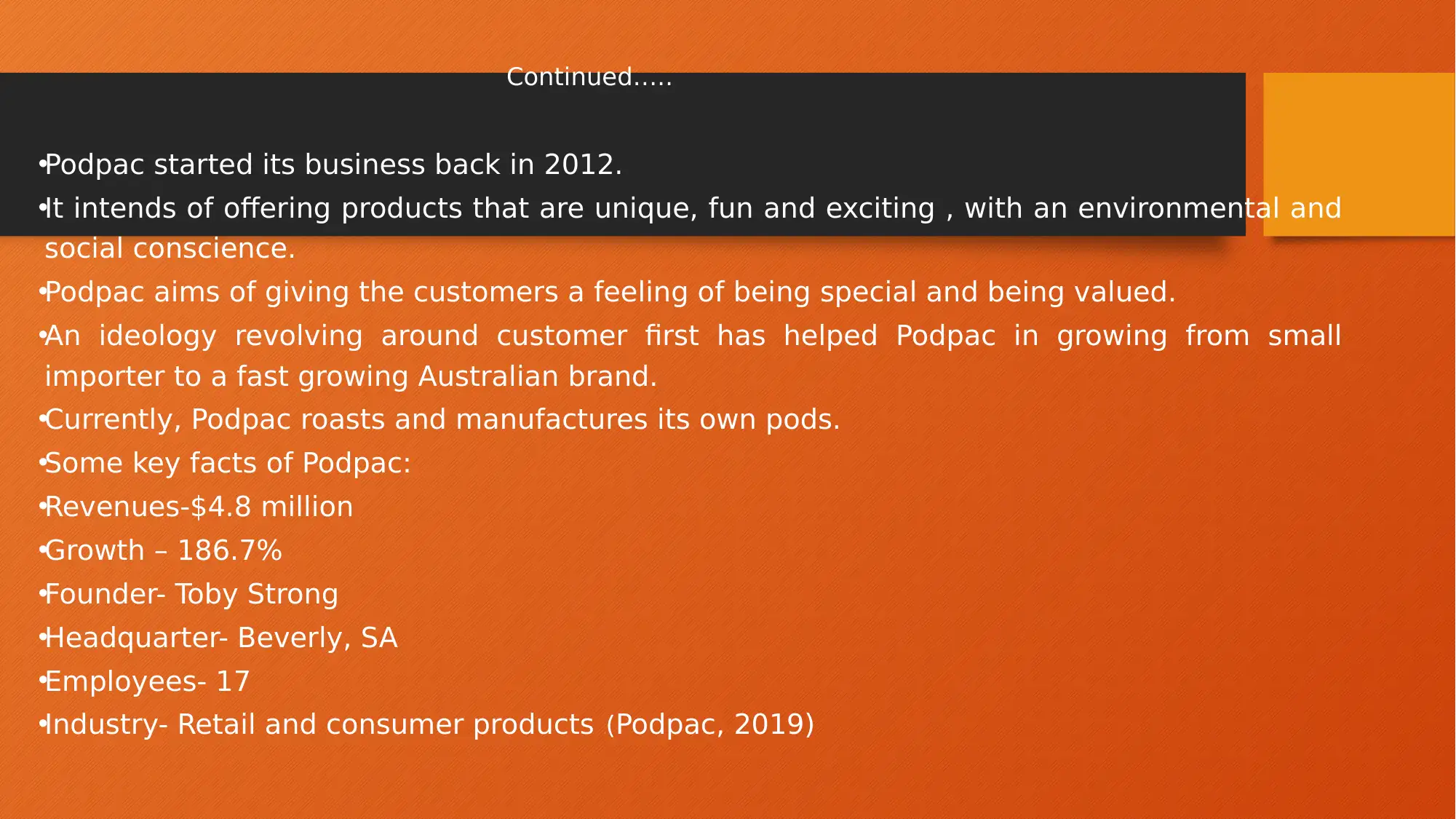
Continued…..
•Podpac started its business back in 2012.
•It intends of offering products that are unique, fun and exciting , with an environmental and
social conscience.
•Podpac aims of giving the customers a feeling of being special and being valued.
•An ideology revolving around customer first has helped Podpac in growing from small
importer to a fast growing Australian brand.
•Currently, Podpac roasts and manufactures its own pods.
•Some key facts of Podpac:
•Revenues-$4.8 million
•Growth – 186.7%
•Founder- Toby Strong
•Headquarter- Beverly, SA
•Employees- 17
•Industry- Retail and consumer products ((Podpac, 2019)
•Podpac started its business back in 2012.
•It intends of offering products that are unique, fun and exciting , with an environmental and
social conscience.
•Podpac aims of giving the customers a feeling of being special and being valued.
•An ideology revolving around customer first has helped Podpac in growing from small
importer to a fast growing Australian brand.
•Currently, Podpac roasts and manufactures its own pods.
•Some key facts of Podpac:
•Revenues-$4.8 million
•Growth – 186.7%
•Founder- Toby Strong
•Headquarter- Beverly, SA
•Employees- 17
•Industry- Retail and consumer products ((Podpac, 2019)
Paraphrase This Document
Need a fresh take? Get an instant paraphrase of this document with our AI Paraphraser

Product Overview
• Podpac expertise in creating the biggest range of easy to use and
great tasting pods and also some amazing value bundles.
• Podpac expertise in creating the biggest range of easy to use and
great tasting pods and also some amazing value bundles.
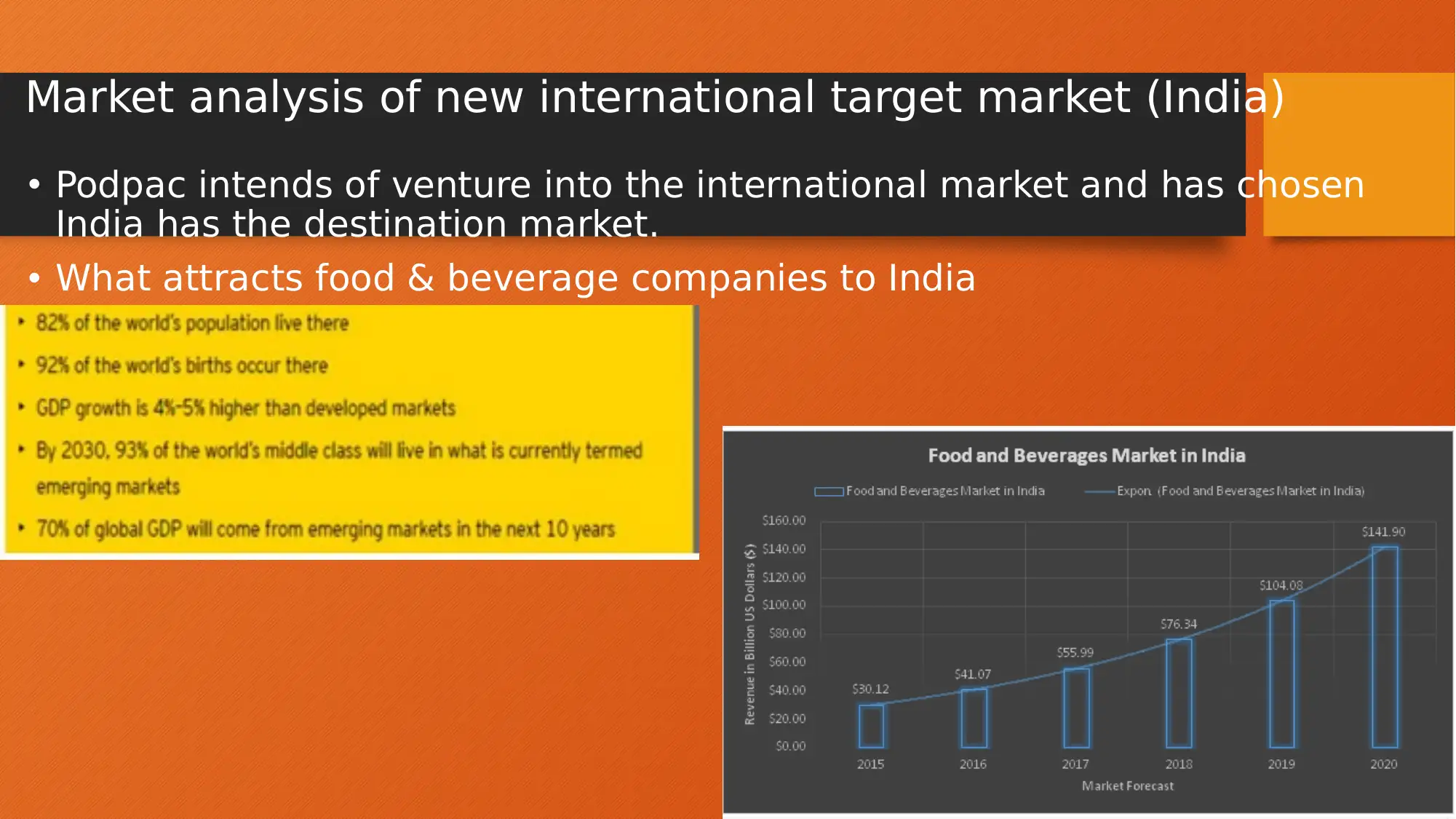
Market analysis of new international target market (India)
• Podpac intends of venture into the international market and has chosen
India has the destination market.
• What attracts food & beverage companies to India
• Podpac intends of venture into the international market and has chosen
India has the destination market.
• What attracts food & beverage companies to India
⊘ This is a preview!⊘
Do you want full access?
Subscribe today to unlock all pages.

Trusted by 1+ million students worldwide
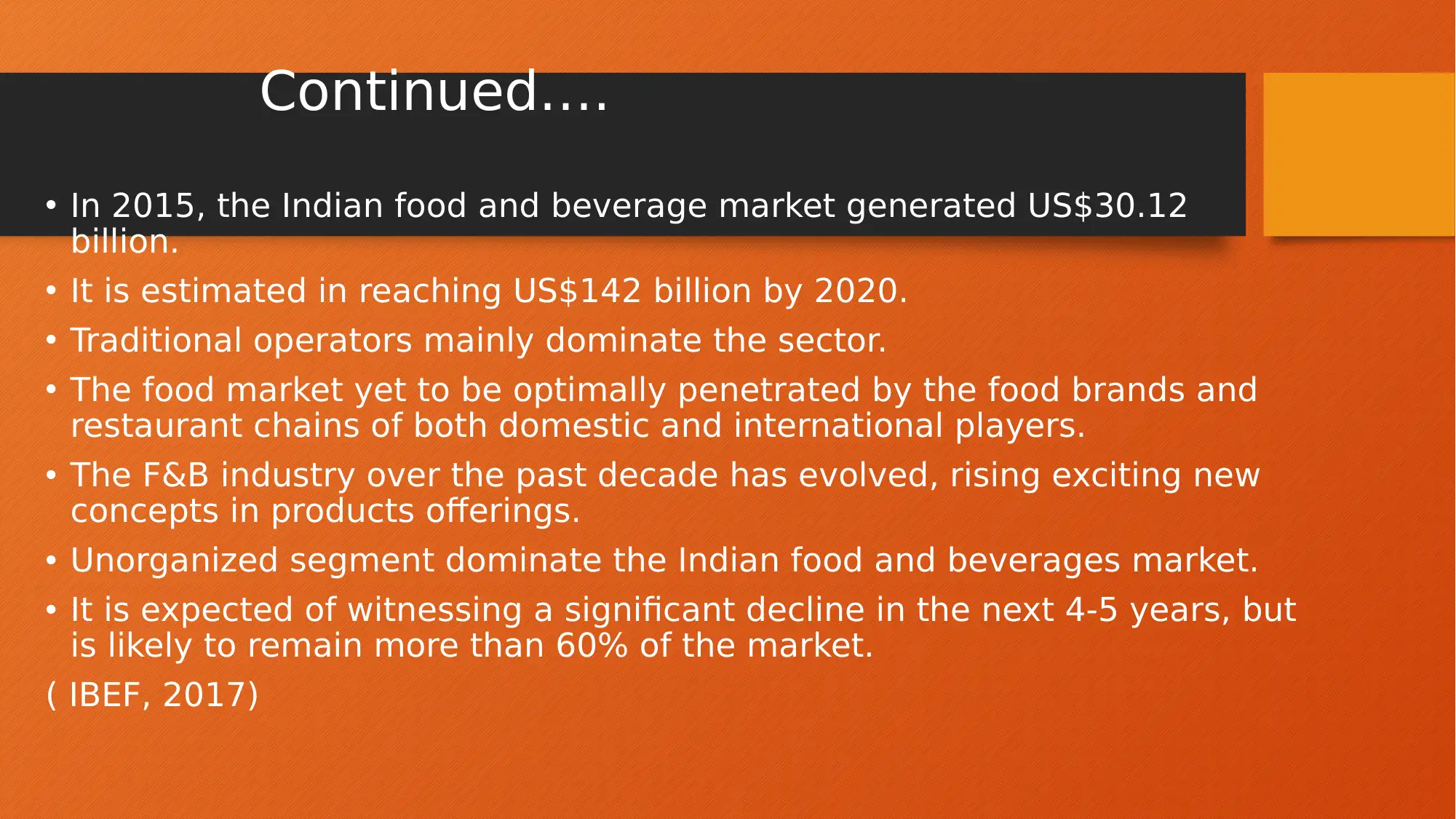
Continued….
• In 2015, the Indian food and beverage market generated US$30.12
billion.
• It is estimated in reaching US$142 billion by 2020.
• Traditional operators mainly dominate the sector.
• The food market yet to be optimally penetrated by the food brands and
restaurant chains of both domestic and international players.
• The F&B industry over the past decade has evolved, rising exciting new
concepts in products offerings.
• Unorganized segment dominate the Indian food and beverages market.
• It is expected of witnessing a significant decline in the next 4-5 years, but
is likely to remain more than 60% of the market.
( IBEF, 2017)
• In 2015, the Indian food and beverage market generated US$30.12
billion.
• It is estimated in reaching US$142 billion by 2020.
• Traditional operators mainly dominate the sector.
• The food market yet to be optimally penetrated by the food brands and
restaurant chains of both domestic and international players.
• The F&B industry over the past decade has evolved, rising exciting new
concepts in products offerings.
• Unorganized segment dominate the Indian food and beverages market.
• It is expected of witnessing a significant decline in the next 4-5 years, but
is likely to remain more than 60% of the market.
( IBEF, 2017)
Paraphrase This Document
Need a fresh take? Get an instant paraphrase of this document with our AI Paraphraser
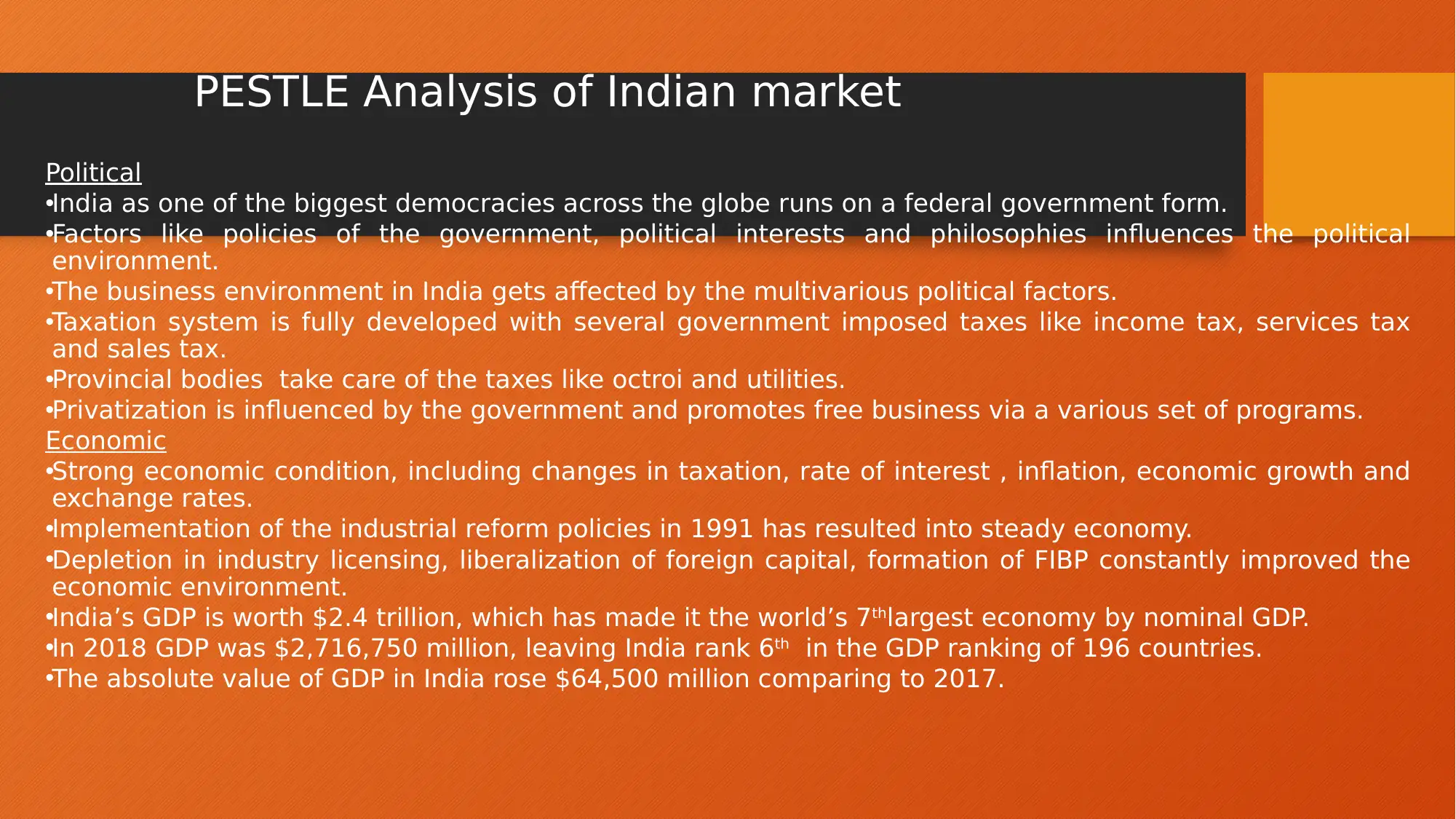
PESTLE Analysis of Indian market
Political
•India as one of the biggest democracies across the globe runs on a federal government form.
•Factors like policies of the government, political interests and philosophies influences the political
environment.
•The business environment in India gets affected by the multivarious political factors.
•Taxation system is fully developed with several government imposed taxes like income tax, services tax
and sales tax.
•Provincial bodies take care of the taxes like octroi and utilities.
•Privatization is influenced by the government and promotes free business via a various set of programs.
Economic
•Strong economic condition, including changes in taxation, rate of interest , inflation, economic growth and
exchange rates.
•Implementation of the industrial reform policies in 1991 has resulted into steady economy.
•Depletion in industry licensing, liberalization of foreign capital, formation of FIBP constantly improved the
economic environment.
•India’s GDP is worth $2.4 trillion, which has made it the world’s 7thlargest economy by nominal GDP.
•In 2018 GDP was $2,716,750 million, leaving India rank 6th in the GDP ranking of 196 countries.
•The absolute value of GDP in India rose $64,500 million comparing to 2017.
Political
•India as one of the biggest democracies across the globe runs on a federal government form.
•Factors like policies of the government, political interests and philosophies influences the political
environment.
•The business environment in India gets affected by the multivarious political factors.
•Taxation system is fully developed with several government imposed taxes like income tax, services tax
and sales tax.
•Provincial bodies take care of the taxes like octroi and utilities.
•Privatization is influenced by the government and promotes free business via a various set of programs.
Economic
•Strong economic condition, including changes in taxation, rate of interest , inflation, economic growth and
exchange rates.
•Implementation of the industrial reform policies in 1991 has resulted into steady economy.
•Depletion in industry licensing, liberalization of foreign capital, formation of FIBP constantly improved the
economic environment.
•India’s GDP is worth $2.4 trillion, which has made it the world’s 7thlargest economy by nominal GDP.
•In 2018 GDP was $2,716,750 million, leaving India rank 6th in the GDP ranking of 196 countries.
•The absolute value of GDP in India rose $64,500 million comparing to 2017.
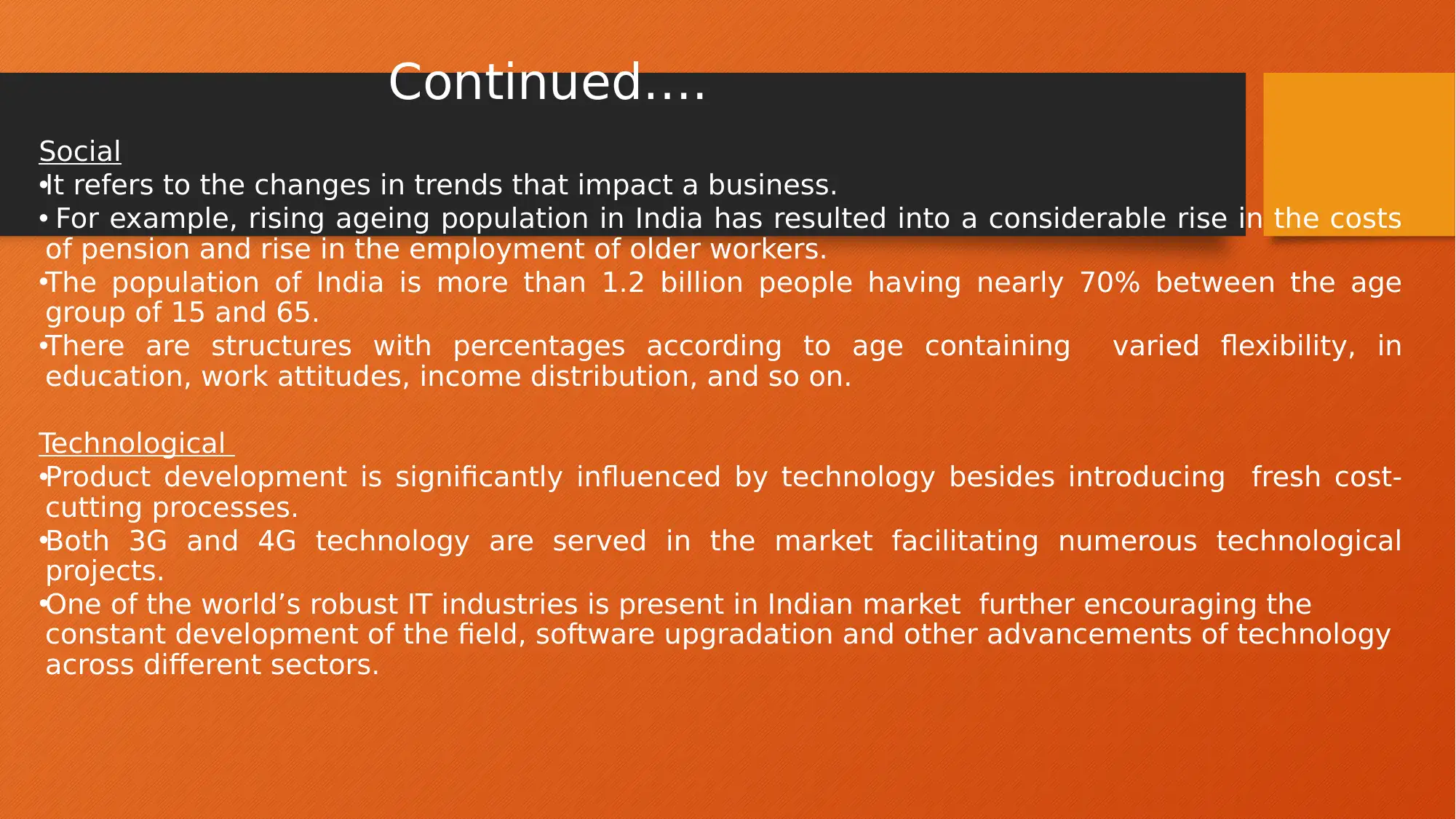
Continued….
Social
•It refers to the changes in trends that impact a business.
• For example, rising ageing population in India has resulted into a considerable rise in the costs
of pension and rise in the employment of older workers.
•The population of India is more than 1.2 billion people having nearly 70% between the age
group of 15 and 65.
•There are structures with percentages according to age containing varied flexibility, in
education, work attitudes, income distribution, and so on.
Technological
•Product development is significantly influenced by technology besides introducing fresh cost-
cutting processes.
•Both 3G and 4G technology are served in the market facilitating numerous technological
projects.
•One of the world’s robust IT industries is present in Indian market further encouraging the
constant development of the field, software upgradation and other advancements of technology
across different sectors.
Social
•It refers to the changes in trends that impact a business.
• For example, rising ageing population in India has resulted into a considerable rise in the costs
of pension and rise in the employment of older workers.
•The population of India is more than 1.2 billion people having nearly 70% between the age
group of 15 and 65.
•There are structures with percentages according to age containing varied flexibility, in
education, work attitudes, income distribution, and so on.
Technological
•Product development is significantly influenced by technology besides introducing fresh cost-
cutting processes.
•Both 3G and 4G technology are served in the market facilitating numerous technological
projects.
•One of the world’s robust IT industries is present in Indian market further encouraging the
constant development of the field, software upgradation and other advancements of technology
across different sectors.
⊘ This is a preview!⊘
Do you want full access?
Subscribe today to unlock all pages.

Trusted by 1+ million students worldwide
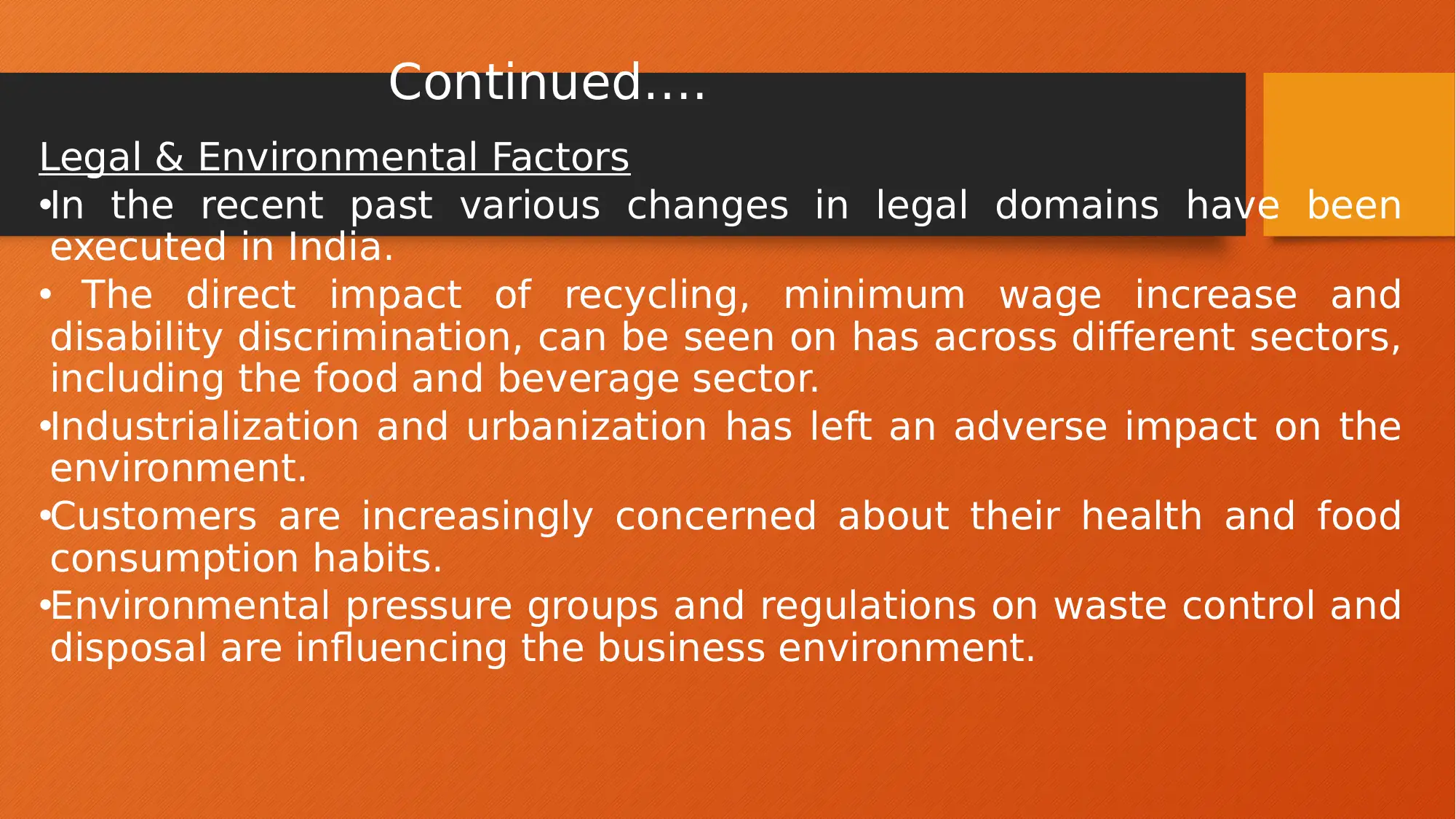
Continued….
Legal & Environmental Factors
•In the recent past various changes in legal domains have been
executed in India.
• The direct impact of recycling, minimum wage increase and
disability discrimination, can be seen on has across different sectors,
including the food and beverage sector.
•Industrialization and urbanization has left an adverse impact on the
environment.
•Customers are increasingly concerned about their health and food
consumption habits.
•Environmental pressure groups and regulations on waste control and
disposal are influencing the business environment.
Legal & Environmental Factors
•In the recent past various changes in legal domains have been
executed in India.
• The direct impact of recycling, minimum wage increase and
disability discrimination, can be seen on has across different sectors,
including the food and beverage sector.
•Industrialization and urbanization has left an adverse impact on the
environment.
•Customers are increasingly concerned about their health and food
consumption habits.
•Environmental pressure groups and regulations on waste control and
disposal are influencing the business environment.
Paraphrase This Document
Need a fresh take? Get an instant paraphrase of this document with our AI Paraphraser
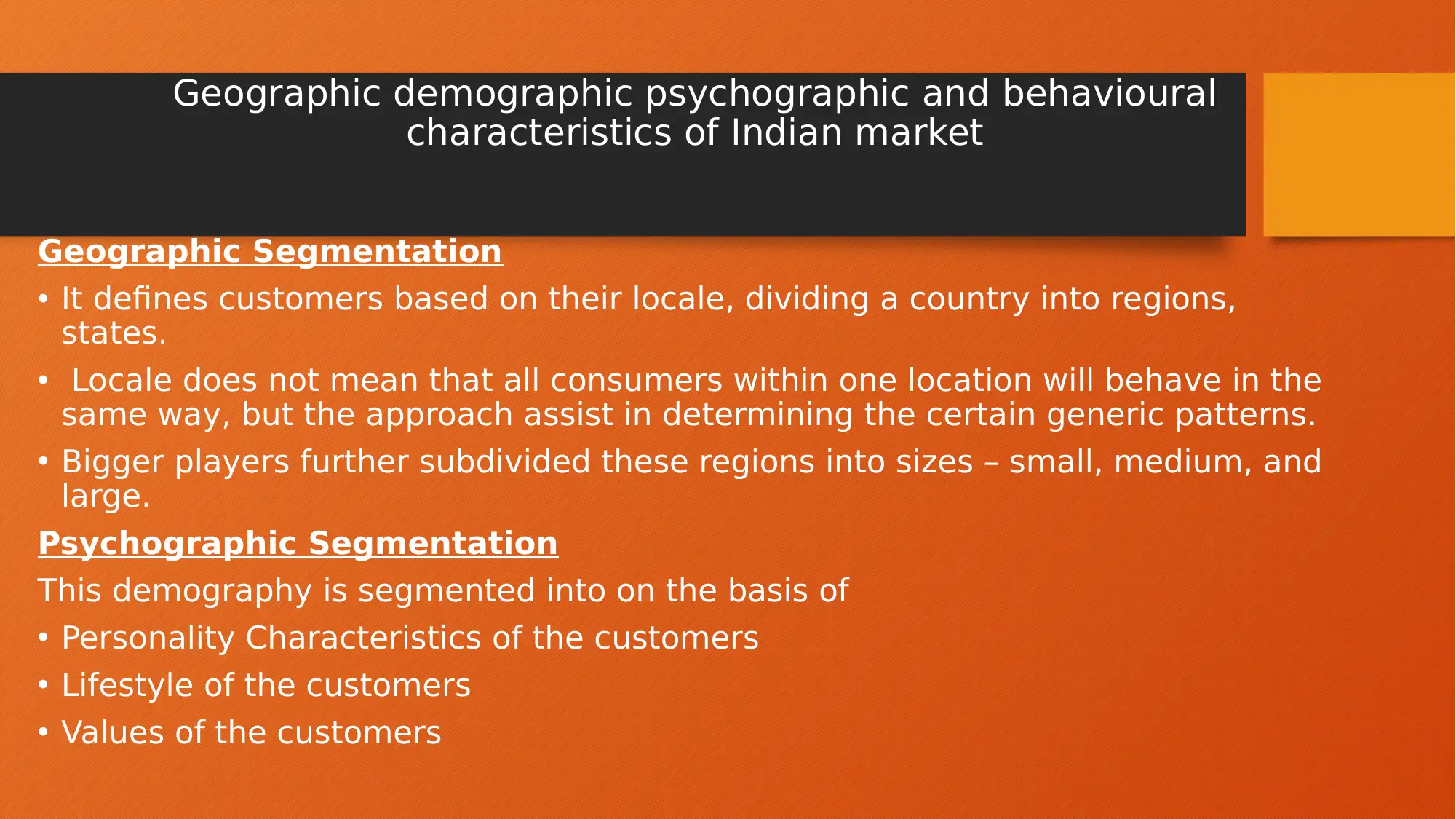
Geographic demographic psychographic and behavioural
characteristics of Indian market
Geographic Segmentation
• It defines customers based on their locale, dividing a country into regions,
states.
• Locale does not mean that all consumers within one location will behave in the
same way, but the approach assist in determining the certain generic patterns.
• Bigger players further subdivided these regions into sizes – small, medium, and
large.
Psychographic Segmentation
This demography is segmented into on the basis of
• Personality Characteristics of the customers
• Lifestyle of the customers
• Values of the customers
characteristics of Indian market
Geographic Segmentation
• It defines customers based on their locale, dividing a country into regions,
states.
• Locale does not mean that all consumers within one location will behave in the
same way, but the approach assist in determining the certain generic patterns.
• Bigger players further subdivided these regions into sizes – small, medium, and
large.
Psychographic Segmentation
This demography is segmented into on the basis of
• Personality Characteristics of the customers
• Lifestyle of the customers
• Values of the customers
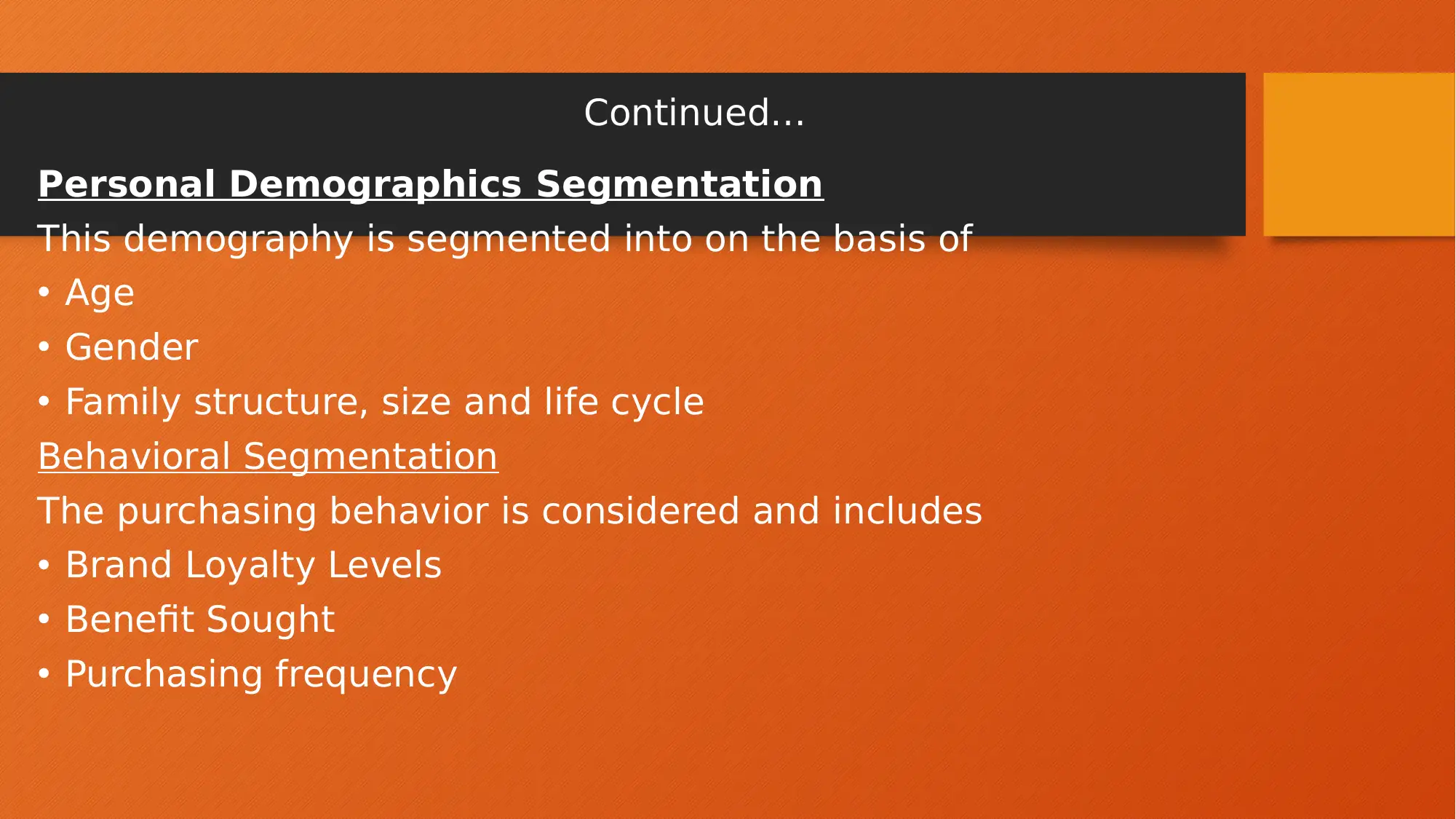
Continued…
Personal Demographics Segmentation
This demography is segmented into on the basis of
• Age
• Gender
• Family structure, size and life cycle
Behavioral Segmentation
The purchasing behavior is considered and includes
• Brand Loyalty Levels
• Benefit Sought
• Purchasing frequency
Personal Demographics Segmentation
This demography is segmented into on the basis of
• Age
• Gender
• Family structure, size and life cycle
Behavioral Segmentation
The purchasing behavior is considered and includes
• Brand Loyalty Levels
• Benefit Sought
• Purchasing frequency
⊘ This is a preview!⊘
Do you want full access?
Subscribe today to unlock all pages.

Trusted by 1+ million students worldwide
1 out of 16
Related Documents
Your All-in-One AI-Powered Toolkit for Academic Success.
+13062052269
info@desklib.com
Available 24*7 on WhatsApp / Email
![[object Object]](/_next/static/media/star-bottom.7253800d.svg)
Unlock your academic potential
Copyright © 2020–2025 A2Z Services. All Rights Reserved. Developed and managed by ZUCOL.





